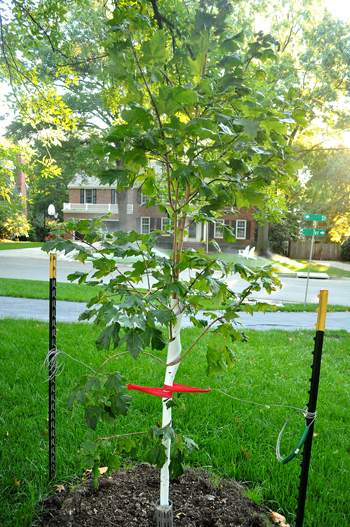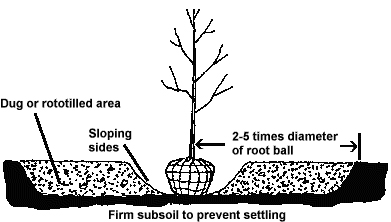Fall Tree and Shrub Planting Instructions
Return to Trees and Shrubs Agent Articles

The heat and drought conditions that summer can bring take their toll on a number of trees and shrubs in the landscape. The challenge we face is replacing these valuable assets in the landscape. The fall season is an excellent time to plant new trees and shrubs in the landscape. Fall planting allows for root development to occur prior to winter’s arrival. These fall roots help the plant become established before the hot, dry conditions of the following summer arrive.
Best Time to Plant Tree and Shrubs in the Fall
The ideal time to plant in the fall is between early September and the end of October. Planting later into November decreases the amount of root growth before the soil cools.
Right Plant Right Place
Planting in fall varies little from spring procedures. Most important is to select the right plant for the right location. This will require research before heading to the nursery to pick out the plant. Know the height, spread and shape of the plant that is needed in the landscape. Always plan for the mature size of the plant, not what you see in a nursery pot. This prevents plants from overtaking the allotted space and reduces maintenance such as pruning.
How to Dig the Planting Hole for Trees and Shrubs

The planting hole for trees and shrubs is important. It is often said, dig a hundred dollar hole for a twenty-five dollar plant. This is truer now than ever with current research. It is better to dig the hole wider than deeper. Digging deeper than the root ball depth causes the plant to settle. This settling results in an unhappy root system that is often prone to decline in our heavy clay soils.
The width of the planting hole should be two to five times the diameter of the root ball. This loose soil around the root ball allows for quick root growth into the soil from the root ball. When backfilling, do not stomp the soil, as this causes compaction and slows root growth. Either lightly firm the soil or allow water to naturally settle the soil.
Water to Keep the Roots Moist
Once the tree or shrub is planted keep it properly watered. During winter the soil does not dry out as quickly as summer. Check the moisture level and water as needed throughout the entire winter. Dry soil conditions during winter are one of the main drawbacks to fall planting. We often forget to water during the cold of winter. The soil will absorb water unless frozen. When watering, deeply soak the soil and allow it to dry before reapplying.
Should I Fertilize Newly Planted Trees and Shrubs?
Normally, young trees and shrubs are not fertilized at the time of planting. Wait one growing season before applying the nutrients. The only exception would be a root starter type fertilizer. Establishing roots is more important in the early stages of growth than top growth.
Not all trees should be planted in the fall
Avoid fall planting of trees in locations that are prone to excessive cold winter winds or cannot be watered. Trees and shrubs that tend to stress during Kansas City summers are also probably better planted in the spring than fall.
Take advantage of the fall season and add new trees and shrubs to the landscape, it is a great time. But remember, care is important for success just as in the spring.
Have questions? The Garden Hotline is staffed by trained EMG volunteers and Extension staff who will assist you with questions.
Phone: (913) 715-7050
Email: garden.help@jocogov.org